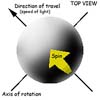| . |  |
. |
Athens OH (SPX) Feb 14, 2005 Nanoscientists dream of developing a quantum computer, a device the size of a grain of sand that could be faster and more powerful than today's PCs. They've identified tiny artificial atoms � called "quantum dots" � as the most likely materials to build these machines, but have been puzzled by the dots' unpredictable behavior at the nanoscale. Now a team of Ohio University physicists thinks it's found the problem � and has proposed a blueprint for building a better quantum dot. The researchers, who published their findings in this week's issue of Physical Review Letters, argue that defects formed during creation of the quantum dots operate as a barrier to scientific experimentation. Experimental scientists in Germany had blasted the quantum dots with light to create the quantum mechanical state needed to run a quantum computer. But they couldn't consistently control that state, explained Sergio Ulloa, an Ohio University professor of physics and astronomy. Jose Villas-Boas, a postdoctoral fellow at Ohio University, Ulloa and Associate Professor Alexander Govorov developed theoretical models to learn what went wrong. The problem, they argued, happens during the creation of the type of quantum dots under study. Using a molecular beam epitaxy chamber, scientists spray paint a surface with atoms under high temperatures, creating an atomic coating. As more layers are added, the quantum dots bead up on the surface like droplets of water, Ulloa said. But a fine residue left behind on the surface that Ulloa calls the "wetting layer" can cause problems during experiments. When experimental scientists blasted the quantum dots with a beam of light in previous studies, the wetting layer caused interference, instead of allowing the light to enter the dot and trigger the quantum state, he explained. The study suggests that scientists could tweak the process by re-focusing the beam of light or changing the duration of the light pulses to negate the effects of the wetting layer, Villas-Boas said. One experimental physicist already has used the theoretical finding to successfully manipulate a quantum dot in the lab, he added. "Now that they know the problem, they realize there are a few ways to avoid it," Villas-Boas said. The new finding ultimately could lead to the creation of a better quantum dot and can help scientists understand more about quantum states, Ulloa added. "It's one more step towards the holy grail of finding a better quantum bit, which hopefully will lead to a quantum computer," he said. Nanoscientists are creating quantum dots in many different ways, Ulloa noted, for use in various applications. The self-assembled type under study could be used in optical electronics and quantum computers. Other types, such as dots grown in a solution, might be used for solar energy applications. The study also will help the Ohio University team better understand how to control the spin of electrons � a property that could be the underlying mechanism behind faster, more efficient future electronic devices, he added. Related Links Ohio University Ohio University's Nanoscale and Quantum Phenomena Institute SpaceDaily Search SpaceDaily Subscribe To SpaceDaily Express  College Station TX (SPX) Feb 08, 2005
College Station TX (SPX) Feb 08, 2005An international team of physicists that includes a Texas A&M University professor has announced discovery of a new spintronic effect in semiconductor chips, the intrinsic spin Hall effect, which puts a new twist on future technology and the possibility for novel circuits with low energy consumption.
|
| ||||||||||
| The content herein, unless otherwise known to be public domain, are Copyright 1995-2016 - Space Media Network. All websites are published in Australia and are solely subject to Australian law and governed by Fair Use principals for news reporting and research purposes. AFP, UPI and IANS news wire stories are copyright Agence France-Presse, United Press International and Indo-Asia News Service. ESA news reports are copyright European Space Agency. All NASA sourced material is public domain. Additional copyrights may apply in whole or part to other bona fide parties. Advertising does not imply endorsement, agreement or approval of any opinions, statements or information provided by Space Media Network on any Web page published or hosted by Space Media Network. Privacy Statement All images and articles appearing on Space Media Network have been edited or digitally altered in some way. Any requests to remove copyright material will be acted upon in a timely and appropriate manner. Any attempt to extort money from Space Media Network will be ignored and reported to Australian Law Enforcement Agencies as a potential case of financial fraud involving the use of a telephonic carriage device or postal service. |